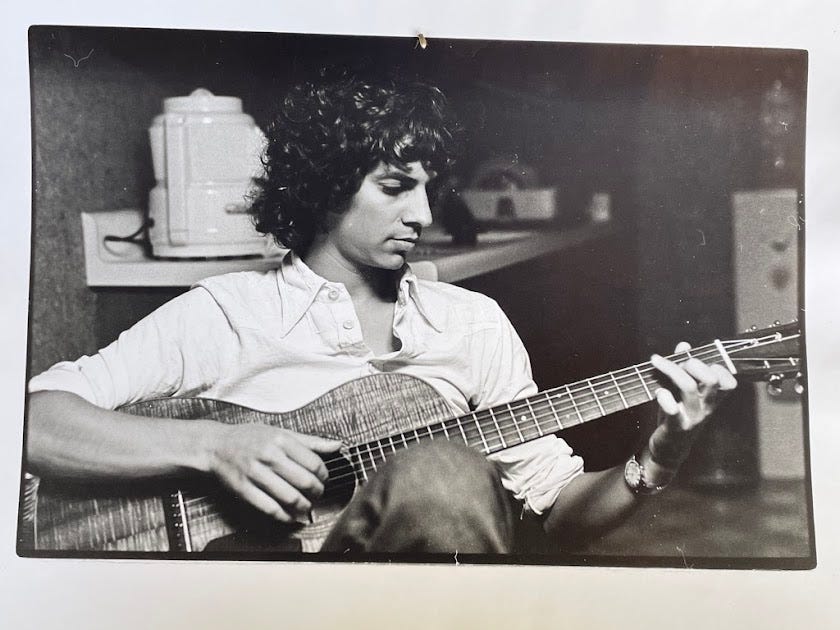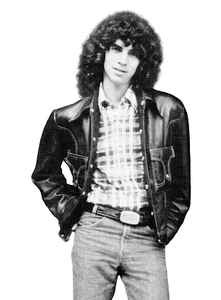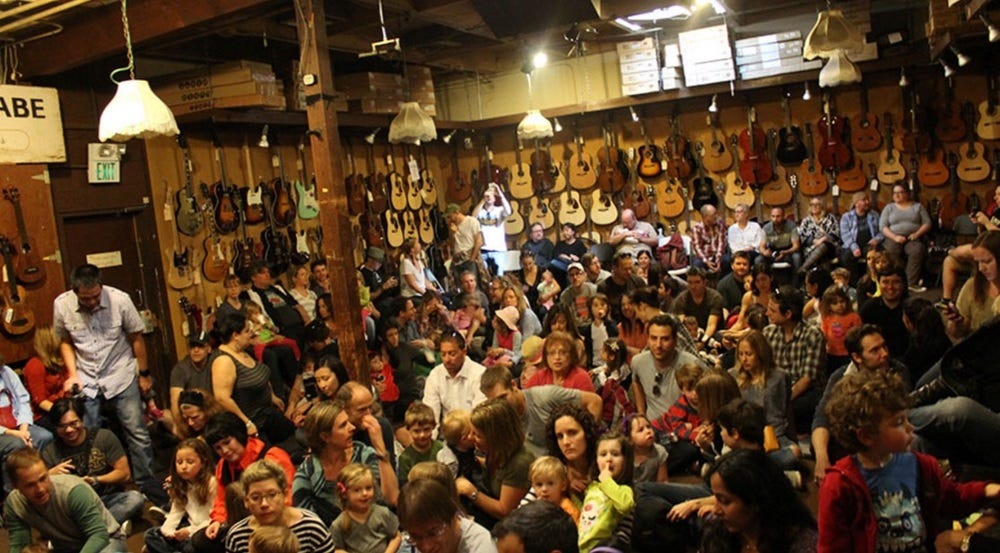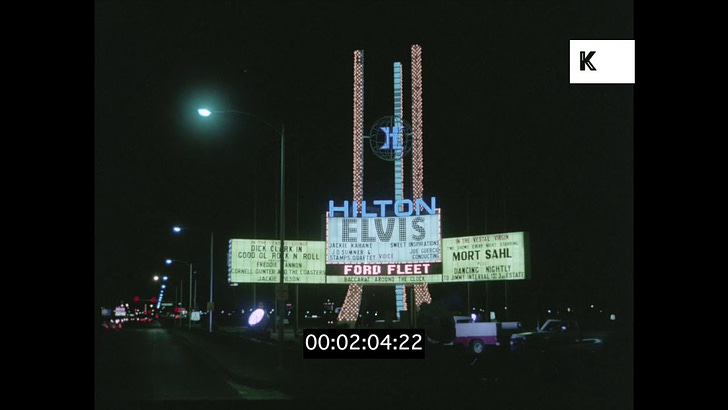Schwartz Stories #2: Jackson, Joni & Stephen Michael Schwartz, 1972-EXCLUSIVE INTERVIEW
It's "Doctors" without borders as Stephen, 19, becomes the surprise "headliner" to a dubious audience of two future Rock'n'Roll Hall of Famers!
Front Row & Backstage is proud to welcome Stephen Michael Schwartz, former 1974 RCA Records singer/songwriter/guitarist. If you’re new here, welcome; Stephen’s telling his story about those mid-’70s days wading through the turbulent waters of the record biz, and we’re currently up to Part #4, accessible by clicking here.
To begin with Part #1, click here.
For now, though, Stephen, armed with a new, original song, takes us back to 1972, and an encounter he had with a burgeoning legend with four popular albums already released, and a newcomer, himself a future rock influencer and Rock Hall inductee!
Stephen Michael Schwartz: “The year was 1972. I was nineteen, in college, and teaching part-time at a preschool called, ‘Kids Unlimited.’ Time was not unlimited, however, so I squeezed in songwriting and performing whenever and wherever I could. What I lacked in monetary funds, I made up for in creative energy.
“It was in March of that year when I first heard ‘Doctor My Eyes’ on the radio by a new artist named Jackson Browne. Ironically, I had just written a ‘Doctor’ song as well, called ‘Doctor’s Daughter.’”
The Story Behind the Song
“My song was inspired by a girl I fell in love with, Anne Robbins, from a suburb of Columbus, Ohio (Bexley). I went to Columbus every summer to visit my grandparents back there, and Anne and I first connected in the summer of 1969.
“Her father was a prominent pediatrician...thus The Doctor's Daughter. I adored her, but our cross-country love affair was very hard to maneuver. I'm still in touch with Anne, who is a Pediatric Neuropsychologist living and practicing in Wynnewood, Pennsylvania [just west of Philadelphia]. So, she is now a Doctor and a Doctor's Daughter!
“Disposable income was a rare commodity, but I loved the sound of Jackson’s song and voice so much that I went out and splurged on his self-titled debut album on Asylum Records.”

The Hand-made’s Tale
“A few months later I read that Jackson was performing at a local club here in the Los Angeles area called McCabe’s Guitar Shop, near the beach in Santa Monica.”

“McCabe’s was, in fact, a well-known acoustic instrument store with hundreds of quality guitars, banjos, dulcimers, and the like, hanging from the walls. I swear, walking in, you could literally smell the various types of wood the luthiers used to construct their wares: Brazilian rosewood, spruce, maple, cedar, and my favorite, Koa wood, a particularly rare and crush-resistant hardwood native to Hawaii.”

“Going to McCabe’s was like walking through a museum, the difference being here you could grab the art off the wall and strum it…even purchase it if you had the coin.
“McCabe’s also has a performance space in the back that could accommodate about 200 people for an intimate concert.
“It was in this setting that I came to that Saturday evening show to see Jackson play. The place was packed with people standing in the back and pouring out through the side hallways,” likely similar to this recent McCabe’s gathering:
“Jackson’s show was wonderful as he worked his way through the set playing almost the entirety of his debut album. Of course, the biggest applause came when he played ‘Doctor My Eyes,’ the hit single everyone knew from the radio that just turned a half-century old!”
“After the show, people headed out back into the night. I lingered and weaved my way around a side hallway until I came to a ‘practice room’ normally used for guitar lessons. Tonight, however, it was Jackson’s dressing room. Somehow, instinctively I knew that.
“Like an actor finding his prop just before hitting his mark, I grabbed one of the many guitars hanging on the wall (they were always in tune), and confidently entered the makeshift dressing room.
“There in a pale light, I saw Jackson Browne sitting with his head in his hands, dejected and complaining about his performance.
“To his left, kneeling next to him, doing her best to comfort her friend, was Joni Mitchell. ‘No, no, you were wonderful!’, Joni insisted. And then, they turned to see this wiry little intruder, guitar in hand. ‘Hi, my name is Stephen Michael Schwartz! I’m a singer-songwriter, and I have a Doctor song too. Can I play it for you?’”
“Without waiting for an answer, I sat down on a vacant chair, and launched into ‘Doctor’s Daughter’!
“Jackson was too upset to give me his attention, but Joni used the opportunity to try and move Jackson into a better frame of mind.
“Come on, let’s listen,” she coaxed. She was very sweet, like a mother bird, giving her chicks the needed attention they required. She smiled and swayed and kept time with my song more for Jackson than for me.”
“I finished, thanked them for their time, and quickly exited the room. I placed the guitar back where I found it, and drove home feeling completely satisfied that I was one more step closer to my dream of being a bonified singer/songwriter.
“Later after recounting the story to family and friends, it hit me how insensitive my actions really were. Bold, perhaps. Pushy for sure. Weren’t these the qualities needed in order to get seen and heard in the entertainment business?
“Perhaps for some. For me, it was a real turning point. I felt terrible that I had side-stepped my own moral compass. Nothing is that important that I push aside someone else’s needs to satisfy my own.
“Jackson Browne was in need of consoling. I saw it and felt it the moment I entered the room, and yet I moved ahead to get my needs met.
“Never again. Never since. Sorry, Jackson.
“Oh yeah…and your Doctor song is better than mine!!!”

Stephen details that particular session: “Michael Omartian played both piano and the Hammond B3 organ. Larry (Carlton) played slide guitar, and Dean Parks played acoustic.
“What we would do is, I would come in and lay down the initial guitar part, because I was much more comfortable singing and playing at the same time to get the right feel. (Producer) David Kershenbaum would then pull my guitar out of the track and have Dean play my part cleanly and methodically.
“It's something I learned in these sessions and carried with me throughout my career: This may sound trite, but there is a real difference between a musician, and someone who just plays an instrument. Studio ‘cats’ are trained to make records. They have great ‘time’ and feel.
“Something that may have taken me five takes to get right, Larry or Dean could get it in one or two takes! And, of course, time in the studio is money. So, I bowed to the best, and watched them work their magic.
“I became a better and better musician by being in their presence. They made the record sound better as a result. To this day, I will still hire a better guitar player than myself to get what I need from time to time. It's really all about the final product.”
Related:
Schwartz Stories #1: Viva Hilton! Stephen Michael Schwartz Meets RCA Label-Mate Elvis Presley, Las Vegas 1974-EXCLUSIVE INTERVIEW
The Las Vegas Hilton: Setting the Stage “I had just finished recording my debut album [Stephen Michael Schwartz, about which more can be read here], and RCA asked me if I would like to fly to Las Vegas and attend an Elvis Presley show at the 30-story Hilton, August 27, 1974. It was a nice perk recording on the same label as ‘The King’!









That's a great story (and I have at least one album recorded live at McCabes!)
There are some funny parallels to the story that opens this profile of Don Freed (also, coincidentally associated with Joni Mitchell) though in slightly better circumstances -- https://www.cbc.ca/news/canada/saskatoon/don-free-metis-musician-1.4970162
In 1968, 19-year-old Don Freed found himself backstage at the Nashville Municipal Auditorium with an acoustic guitar, harmonica and Johnny Cash.
He had five minutes with the Man in Black.
A film crew working on the documentary Johnny Cash! The Man, His World, His Music captured an exchange between the country icon and the slim teen from Saskatoon in hollow sound and grainy colour.
"You write songs? I'd like to hear some of your stuff," said Cash.
"Let's get this done. I've come all this way," Freed responded.
He played Come Away From The Roadside, a plaintive and earnest ballad, then Bank of Mariposa.
Cash was attentive and complimentary, promising to arrange a record company meeting. The final scene of the documentary sequence has Freed doing a grinning pirouette.
...
Wow - great insight into building a song from scratch to demo to studio to master recording - thanks so much Brad and Steve for this look back to a great era in music!!